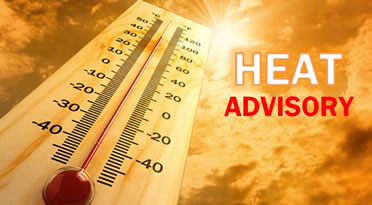
A Heat Advisory has been issued today, September 27, 2024, as temperatures are expected to soar across many regions, posing a significant risk to public health. This advisory, issued by the National Weather Service (NWS), warns of dangerously high temperatures that can lead to heat-related illnesses if proper precautions are not taken. With heat indices predicted to rise above 100°F in various areas, residents are advised to remain cautious and limit outdoor activities. This article will cover essential safety tips, the latest weather updates, and guidance on how to protect yourself and your loved ones during this heatwave.
What is a Heat Advisory?
A Heat Advisory is issued when the combination of high temperatures and humidity creates dangerous conditions for prolonged outdoor exposure. According to the NWS, a heat advisory typically means the heat index is expected to reach at least 100°F for two consecutive hours or more. The heat index measures how hot it feels when factoring in both the temperature and relative humidity. Under these conditions, even a short time outside can lead to heat exhaustion or heat stroke, particularly for vulnerable populations like children, the elderly, and individuals with pre-existing health conditions.
Regions Affected by Today’s Heat Advisory
As of this morning, several regions across the United States have been placed under heat advisories. Notably, the southern and central parts of the country are bracing for higher-than-average temperatures, with cities such as Dallas, Nashville, and Louisville facing significant heat risks.
- Southern U.S. – Texas, Louisiana, and parts of Florida are experiencing extreme heat, with temperatures expected to peak around 102°F and higher in some areas.
- Central U.S. – States like Kentucky, Missouri, and Tennessee have also been issued heat advisories, with heat indices forecasted to hit 105°F due to oppressive humidity.
- Northeast U.S. – Although less impacted, cities like Washington, D.C., and New York will still experience sweltering heat with indices hovering around the 95-100°F mark.
These temperatures can strain local energy grids, increasing the likelihood of power outages, and can also lead to air quality issues, particularly in densely populated urban areas.
For more detailed weather forecasts and the latest updates for your region, visit Newsify.
Safety Tips for Coping with Extreme Heat
The combination of high temperatures and humidity can be dangerous if precautions are not taken. Below are some critical steps to stay safe during the heat advisory:
1. Stay Hydrated
During extreme heat, your body loses more fluids through sweat, leading to dehydration. Drink plenty of water throughout the day, even if you don’t feel thirsty. Avoid sugary, caffeinated, or alcoholic beverages, as they can contribute to dehydration.
2. Limit Outdoor Activities
Where possible, limit time spent outdoors, especially during peak sun hours between 10 a.m. and 4 p.m. If outdoor activity is unavoidable, take frequent breaks in the shade and wear loose, light-colored clothing to stay cool.
3. Recognize Signs of Heat-Related Illness
Knowing the symptoms of heat exhaustion and heat stroke can save lives. Symptoms of heat exhaustion include dizziness, nausea, excessive sweating, and muscle cramps. Heat stroke, a more severe condition, presents with confusion, lack of sweating, and a rapid, strong pulse. If you or someone you know exhibits these symptoms, seek medical attention immediately.
4. Use Air Conditioning
Air conditioning is the most effective way to cool off during extreme heat. If you don’t have air conditioning at home, consider spending time in public cooling centers, libraries, shopping malls, or community centers. Even a few hours in a cooler environment can help reduce the risk of heat-related illness.
5. Check on Vulnerable Individuals
Make it a priority to check in on elderly family members, neighbors, and individuals with pre-existing conditions, as they are more susceptible to heat illnesses. Ensure they have access to cooling methods and are drinking enough fluids.
The Impact of Heatwaves on Public Health and the Environment
Heatwaves are becoming increasingly common as global temperatures rise due to climate change. Prolonged periods of extreme heat not only affect public health but also place a significant burden on local infrastructure, agriculture, and the economy.
Health Risks
Heatwaves are particularly dangerous for vulnerable populations, including infants, the elderly, and those with chronic medical conditions. Prolonged exposure to high temperatures can result in heat exhaustion, heat stroke, and in severe cases, death. In fact, heat-related illnesses are one of the leading causes of weather-related deaths in the U.S.
Heatwaves can also exacerbate conditions like asthma, particularly in urban areas where air quality tends to decline during high temperatures. The increase in ground-level ozone pollution can lead to respiratory issues, especially in areas with poor air circulation.
Environmental Impact
The effects of extreme heat are not confined to human health. Rising temperatures place stress on agricultural systems, resulting in reduced crop yields and increased demand for water. Additionally, ecosystems are disrupted as wildlife struggles to adapt to rising temperatures and altered habitats.
For more on the environmental impact of heatwaves and other related issues, check out the latest climate reports at Newsify.
How to Keep Your Home Cool During a Heat Advisory
Staying indoors can only be effective if your living environment is sufficiently cool. Here are a few tips to maintain a cool indoor temperature:
- Close Blinds and Curtains – Keeping sunlight out can significantly reduce indoor temperatures, especially during peak sun hours.
- Use Fans Strategically – While fans don’t lower the temperature, they can create airflow that makes it feel cooler. Consider placing a bowl of ice in front of the fan to cool the air.
- Limit Appliance Use – Stoves, ovens, and dryers generate heat, contributing to indoor temperature rises. Try to avoid using these appliances during the hottest parts of the day.
- Opt for Cold Showers – A cool shower can help lower your body temperature and provide immediate relief during intense heat.
External Resources and Assistance
Several resources are available to help individuals cope with extreme heat, including cooling centers and health advisories. Below are some useful links:
- CDC Extreme Heat Guidelines – The Centers for Disease Control and Prevention (CDC) offers comprehensive tips on staying safe during extreme heat here.
- Cooling Centers – Many cities have opened public cooling centers to provide air-conditioned spaces for those in need. Contact your local government or visit the NWS website for more information on locations near you.
For ongoing updates about the heat advisory and other weather alerts, visit Newsify.
Conclusion: Stay Cool and Stay Safe
Today’s heat advisory serves as a stark reminder of the growing risk of extreme temperatures. By following safety guidelines, staying informed about local weather conditions, and taking proactive measures to cool down, you can protect yourself and your loved ones during this heatwave.
For up-to-the-minute news on the heat advisory and other weather-related updates, continue following Newsify for reliable, real-time information.









Leave a Reply